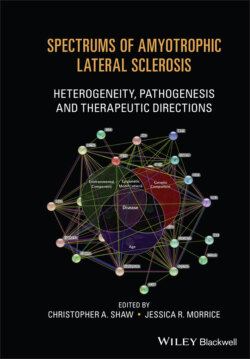Читать книгу Spectrums of Amyotrophic Lateral Sclerosis - Группа авторов - Страница 7
Foreword
ОглавлениеCharles Krieger
Department of Biomedical Physiology and Kinesiology, Simon Fraser University, Burnaby, British Columbia, Canada
Department of Medicine, University of British Columbia, Vancouver, British Columbia, Canada
Division of Neurology, Vancouver Coastal Health, Vancouver, British Columbia, Canada
The past decade or so has seen a substantial increase in the extent of research directly or indirectly related to amyotrophic lateral sclerosis (ALS). Unfortunately, this research has had limited impact on the clinical course of patients with ALS, suggesting that in many fundamental ways we do not really understand this disease. Numerous observations still defy a clear explanation. For instance, how is it that mutations in various genes, seemingly without a clear interaction in a signaling cascade or pathophysiologic mechanism, all result in a disease with a superficially similar phenotype, a phenotype that is shared with patients where no known gene mutations are present? How is it that the rate of progression of ALS is so rapid and unresponsive to modulation in some patients, yet a lucky few will have the disease course slow substantially? Why are there specific patterns of nervous system involvement in ALS such as “classic” ALS (Charcot type), bulbar ALS (perhaps better described by the original name of “glosso‐labio‐pharyngeal paralysis”), progressive muscular atrophy, and primary lateral sclerosis? What is the relation between the loss of motoneurons and their axons and the progressive decline in corticospinal and other descending connections? What is the basis of fasciculations? How does ALS “spread” so rapidly in the nervous system? These and other questions remain unanswered.
It is also interesting to look back at how our view of ALS research has changed over time. A clinician or scientist of 25 or 50 years ago would not have seen much investigation into ALS. To those of us who were involved with ALS at that time, the disease appeared neglected. Potentially, to a researcher investigating ALS 50 years ago, it also might have seemed that a treatment for this disease would be relatively straightforward, compared to the treatment of other neurological diseases like Alzheimer's disease or Parkinson's disease. ALS was characterized by the loss of neuronal populations that were well studied, even decades ago, and affected cells might be amenable to the delivery of intrathecal or intramuscular treatment to augment the health of dying neurons and so prolong patient survival.
How times have changed! Instead of being a neglected disorder, there has been considerable scientific and public interest in ALS, due not only to events like the Ice Bucket Challenge, but also to social media and increasing public awareness. Second, the initial hopes that the disease would turn out to be treatable and responsive to trophic molecules and other factors that would improve the “metabolism” of motoneurons have not yet borne fruit. In retrospect, it seems clear that given the complexity of motoneuron physiology, the difficulty of successful treatment may not have been fully appreciated. Furthermore, the scientific community generally has woken up to the challenge that ALS poses, and many labs around the world are investigating aspects of the disease: the genetics of ALS, the relation between viruses and ALS, RNA‐binding proteins, risk genes and environmental toxins, as well as other topics that are reviewed in the present volume.
We can only hope that this new volume will be a stimulus for continued research on ALS and result in insights into this enigmatic, frustrating, and tragic illness.
